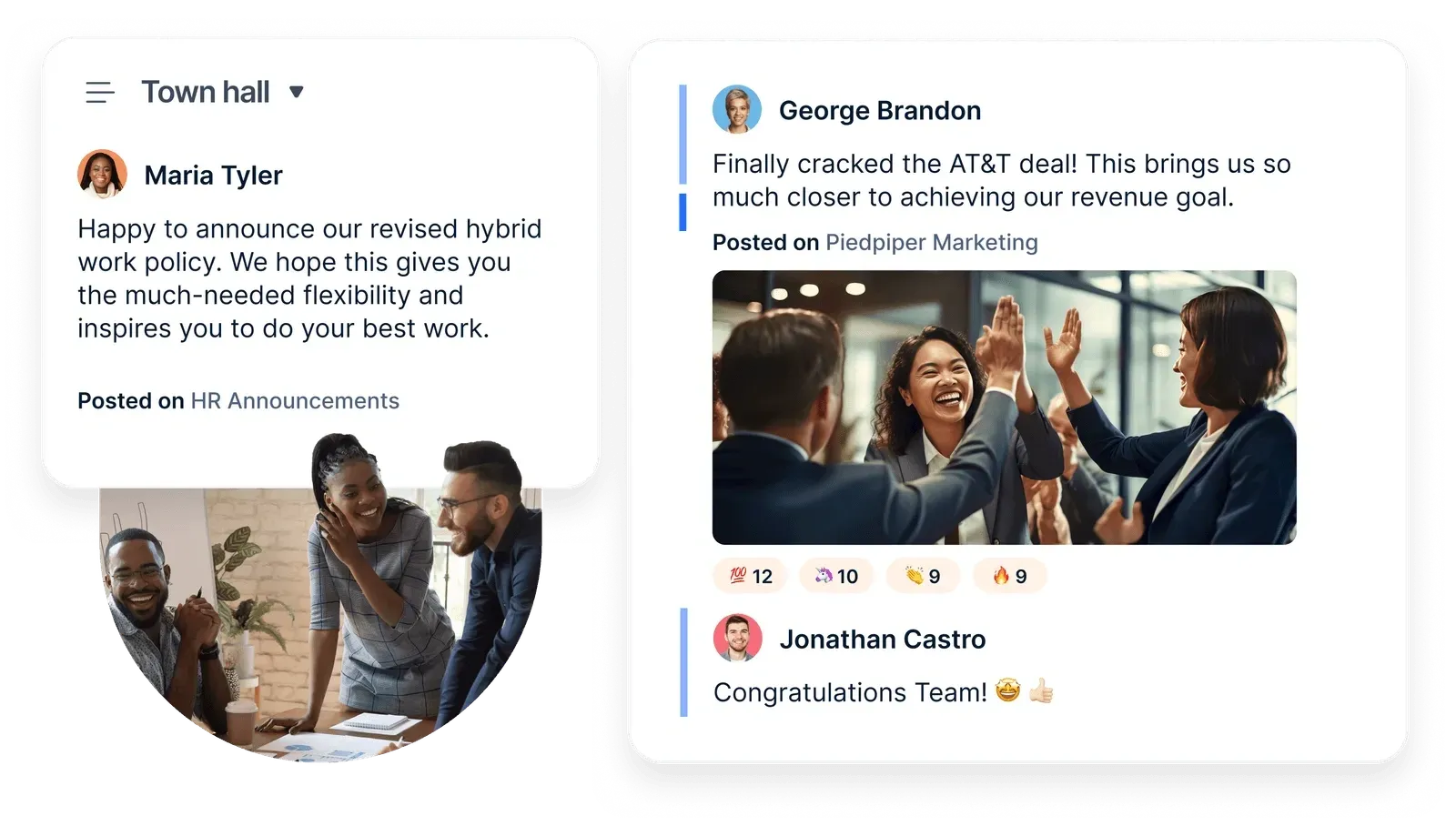Comunicación con los empleados: Tipos, ventajas y buenas prácticas
Una comunicación eficaz con los empleados es esencial para el compromiso, la transparencia y la productividad. Esta guía explora sus tipos, beneficios y mejores prácticas, ayudando a las empresas a crear una cultura en la que los empleados se mantengan informados, alineados y motivados.
En esta página
- ¿Qué es la comunicación con los empleados?
- El coste de una mala comunicación es excepcionalmente alto
- Ventajas de una comunicación interna eficaz en el lugar de trabajo
- ¿Qué es una comunicación eficaz y qué no lo es?
- Comunicación eficaz de los empleados en el lugar de trabajo
- Comunicación ineficaz de los empleados en el lugar de trabajo
- 10 estrategias eficaces de comunicación entre empleados y equipos
- Ejemplos de fallos de comunicación: Aprender de los errores de los demás
- Mejorar la comunicación en el lugar de trabajo con Empuls
- Conclusión
Antes de entrar en profundidad en la comunicación con los empleados y su importancia en el lugar de trabajo, entendamos el término con un sencillo ejemplo.
Al leerlo, George envía inmediatamente un mensaje al jefe de producto, pidiéndole que confirme la posibilidad de la característica para persuadir una venta. El correo electrónico de George suena y consulta su teléfono unos minutos antes de reunirse con el posible cliente.
El correo electrónico es un boletín de la empresa con el asunto Próximo evento en la oficina. Bueno, no es el tipo de respuesta que esperaba con impaciencia, y ahora se siente frustrado.
No sabía que el boletín también incluía el anuncio de la función (por la que preguntaba el cliente potencial) como uno de los elementos clave del próximo lanzamiento.
Si hubiera leído el boletín correctamente, o incluso mejor, si la empresa de George tuviera una intranet en el lugar de trabajo que le mantuviera al tanto de las actualizaciones importantes de las funciones del producto, habría impresionado fácilmente al cliente potencial en lugar de dejarlo decepcionado durante la reunión.
Desde una perspectiva organizativa o empresarial, este ejemplo enseña cinco lecciones cruciales:
- Lección nº 1: La comunicación eficaz con los empleados es vital
- Lección nº 2: Una mala comunicación puede afectar negativamente al crecimiento de una empresa
- Lección nº 3: Comunicar las actualizaciones importantes a toda la empresa es vital
- Lección nº 4: Contar con una sólida plataforma de compromiso de las personas es más importante que nunca
- Lección nº 5: Además de las oportunidades de venta perdidas, una comunicación ineficaz o deficiente con los empleados puede causar estragos en múltiples aspectos de una empresa, entre los que se incluyen los niveles de compromiso de los empleados, la tasa de rotación de empleadosel servicio al cliente, el plazo de entrega de los proyectos, el coste de los litigios y el rendimiento para los accionistas.
Hoy en día, la fluidez de la comunicación de los empleados en el lugar de trabajo dicta cómo se producen las operaciones y el impacto tangible en el RoI. Una comunicación eficaz con los empleados es la base de una plantilla comprometida, y vamos a entenderlo en detalle con algunos ejemplos interesantes.
¿Qué es la comunicación con los empleados?
La comunicación entre empleados significa compartir ideas, sentimientos e información entre los empleados y los empresarios de una empresa.
Antes de la pandemia, los empleados confiaban en la colaboración en tiempo real y la comunicación sincrónica con sus compañeros. Pero esto ya no es así.
Dado que los entornos de trabajo a distancia han llegado para quedarse, es muy necesario que los empresarios:
- Repensar sus estrategias de comunicación con los empleados
- Adoptar comunicaciones asíncronas
- Mantener a los empleados bien informados
- Eliminar los silos interdepartamentales
- Mejorar la experiencia de los empleados
- Reducir la sobrecarga de información
- Asegúrese de que existe una intranet social para que los empleados estén conectados
La comunicación entre los empleados es vital para el éxito de una empresa. Es el "pegamento" que mantiene unida a una empresa. Una estrategia de comunicación eficaz ayuda a mejorar la productividad de los empleados, el compromiso de los empleadosy la colaboración en el lugar de trabajo. Todo ello contribuye a crear una cultura empresarial sólida.
La forma de comunicar la visión, los valores y las estrategias de su empresa influye directamente en los sentimientos de los empleados hacia ella.
Ahora que ha comprendido los fundamentos de la comunicación con los empleados, conozcamos los tipos y su importancia con algunos ejemplos interesantes.
El coste de una mala comunicación es excepcionalmente alto
El cambio hacia el trabajo remoto/híbrido y el metaverso emergente han cimentado la realidad digital, pero la mano de obra se enfrenta a nuevos retos. La mala comunicación es un problema grave y, sin embargo, muchos dirigentes no se dan cuenta de su impacto en los costes.
Según un informe de investigación de The Harris Poll y Grammarly, la mala comunicación en el lugar de trabajo es un problema frecuente que sigue lastrando a empleados y empresas.
Las conclusiones de este estudio no pueden ser ignoradas. Aunque el coste es asombroso, los hechos ponen de manifiesto las amplias repercusiones de una comunicación deficiente en la actualidad y la grave necesidad de replantearse el compromiso y la productividad en el lugar de trabajo.
Los resultados de esta encuesta también revelan la relación entre una comunicación deficiente y la rotación de personal. rotación de personal y la moral. El informe afirma que el 86% de los empleados experimenta problemas de comunicación en el trabajo. Además, los empleados que experimentan problemas de comunicación muchas veces a lo largo del día tienen más probabilidades de estar estresados.
Un fallo en el proceso de comunicación frustra a los empleados, creando un efecto dominó en:
- Compromiso de los empleados
- Productividad de los empleados
- Experiencia del cliente
A medida que evoluciona la mano de obra, es imprescindible mejorar sus comunicaciones con una claridad sobresaliente y fomentar la confianza de los empleados.
Ventajas de una comunicación interna eficaz en el lugar de trabajo
Construir una buena cultura interna es como construir una casa. Si los cimientos no son sólidos, acabará derrumbándose. Una comunicación de equipo eficaz hace que los cimientos de su cultura sean más sanos y fuertes. Los beneficios son increíbles cuando se cuenta con la estrategia de comunicación interna adecuada. Aquí destacamos algunos:
1. Aumenta el compromiso de los empleados
El compromiso de los empleados es el santo grial de las empresas, porque es el sustento de una compañía. Los empleados que no están comprometidos son menos productivos y su estrés puede repercutir en su bienestar general. Se sentirán más frustrados e incapaces de dar el 100% en el trabajo, lo que puede mermar el espíritu de la empresa.
Según un informe McKinseyun aumento del compromiso de los empleados puede incrementar la productividad en un 25 %, lo que repercute en toda la empresa. Sin embargo, solo el 3 % de los empleados se sienten comprometidos en el trabajo.
Cuando las empresas consiguen una buena comunicación interna, mejoran el compromiso de los empleados. Esto demuestra rápidamente el éxito de una empresa, ya que las organizaciones con un mayor compromiso de los empleados obtienen un 22 % más de beneficios.
Aunque algunos empleados son proactivos a la hora de obtener información y hablar con regularidad, no todos los empleados son iguales. Es responsabilidad de los directivos y de la alta dirección poner empeño en la comunicación regular. La comunicación interna puede ayudar a los empleados a sentirse valorados e importantes.
2. Garantiza la transparencia de toda la organización
Una comunicación eficaz con los empleados garantiza la transparencia en una organización, y la apertura asegura la confianza. Los empleados no quieren enterarse de un gran anuncio a través de una tercera persona o de fuentes externas. Quieren enterarse a través de los dirigentes de su empresa o de la alta dirección.
Según un estudio de Slackel 80% de los empleados está interesado en saber cómo se toman las decisiones en su organización.
Esto significa que quieren una mayor transparencia para entender cómo funciona su organización y cómo toma las decisiones la dirección. La transparencia permite que los empleados confíen en sus líderes, y esto fomenta la responsabilidad.
El mismo estudio de Slack también revela que hasta el 55% de las organizaciones se sentían transparentes, y sólo el 18% de los empleados pensaban lo mismo. Las comunicaciones c internas pueden ayudar a salvar la brecha de transparencia y permitir a los empleados confiar y trabajar en pro de los valores y la misión comunes de la empresa.
Las comunicaciones internas permiten una rápida transmisión de la información, ya sea de los altos cargos o entre los empleados. Este flujo de información permite la transparencia, de modo que cada empleado está en la misma página que los demás. Esto puede ayudar a crear una cultura de trabajo sólida.
3. Mantiene a los empleados informados y actualizados
El objetivo de la comunicación interna es mantener al día a los empleados sobre cualquier información que necesiten. A informe de Bambu afirma que el 80% de los empleados quiere saber lo que ocurre en su empresa.
En el mismo informe, el 77% de estas personas especificó explícitamente que puede ayudarles a trabajar mejor, mientras que el 66% dijo que podía mejorar la relación con sus compañeros. Esto demuestra las ganas que tienen los empleados de conocer las novedades de su organización.
Una estrategia eficaz de comunicación interna puede mantener a los empleados al corriente de las novedades de la empresa. Por ejemplo, hay que comunicar a los empleados cualquier cambio en la política de la empresa, en la cultura de trabajo o en los resultados de la empresa.
4. Ayuda en tiempos de crisis
La comunicación interna puede ayudar en la gestión de crisis. En un mundo ideal, las organizaciones no experimentan ningún problema. Pero la realidad dista mucho de ello. Continúan las fusiones, adquisiciones, crisis macroeconómicas, pandemias, situaciones políticas, etc. Una acción orgánica puede tener que despedir a unos cuantos o a muchos empleados o tomar cualquier decisión desagradable en tiempos de crisis.
En algunos casos, los equipos tienen que reestructurarse, etc. Una crisis puede afectar a una empresa de cualquier tamaño, y su gente necesita información precisa sobre lo que está ocurriendo en la empresa. La comunicación interna puede ayudar a gestionar y garantizar que no haya desinformación.
Los rumores pueden propagarse rápidamente y esto puede causar toxicidad en el lugar de trabajo. Además, la gente puede perder la confianza y estar menos comprometida debido a una mala comunicación interna. Sin embargo, las organizaciones con una estrategia de comunicación interna adecuada pueden prosperar incluso en tiempos difíciles.
La comunicación interna puede facilitar las conversaciones difíciles para que los empleados comprendan el panorama completo y por qué se está produciendo algo desagradable, como un despido. Esto puede ayudar a los empleados a respetar su organización, creando un entorno de debate abierto.
5. Ayuda a la comunicación externa
La comunicación interna y la externa suelen considerarse entidades separadas en el mundo empresarial, pero no lo son. Según un informe de informe de Bambuel 63% de los empleados afirma que una comunicación interna adecuada podría ayudarles a convertirse en defensores de la marca y a correr la voz sobre su empresa.
Piense en ello. Los empleados actúan como conocedores de la empresa, ya que trabajan en ella. Cuando los empleados dicen algo sobre la empresa, ya sea bueno o malo, tendrá más peso porque forman parte de la organización. Esto puede tener efectos positivos o negativos en función de lo que el empleado diga de la empresa.
Cuando la comunicación interna se hace bien, los empleados saben lo que está pasando y se sienten parte del equipo. Los empleados que tienen estos sentimientos positivos dicen cosas buenas de la organización. Ya sea en las redes sociales o con familiares y amigos, estos empleados tendrán palabras alentadoras respecto a la organización.
De este modo, los empleados pueden ser embajadores creíbles cuando están satisfechos con el trato que reciben. Los empleados que tienen contacto directo con los clientes también se beneficiarán de las comunicaciones internas. Lo que sientan por la empresa se reflejará en cómo hablen a los clientes.
6. Fomenta la cultura y los valores de la empresa
Una cultura sólida en el lugar de trabajo puede permitir a las empresas retener y atraer a los mejores talentos, lo que repercute positivamente en los resultados empresariales. Según un estudio de estudio de Gallupla cultura de trabajo es vital para el éxito de una empresa, y los mejores empleados están interesados en trabajar en un lugar con una cultura de trabajo excepcional.
Las comunicaciones internas pueden ayudar a fomentar una cultura de trabajo positiva y tener un profundo impacto en los resultados. La cultura y los valores de la empresa entretejidos en las comunicaciones internas pueden hacer que los empleados se sientan bien trabajando en ella e impulsar un entorno laboral saludable.
Una cultura próspera en el lugar de trabajo ayuda a alinear a los empleados con los objetivos de la organización. Según un estudio, sólo el 40% de los empleados saben cómo contribuyen a una organización. La comunicación interna permite a los empleados comprender claramente su importancia en el conjunto, lo que les anima a trabajar juntos como un equipo.
La comunicación interna puede ayudar a las personas a trabajar juntas con eficacia y eficiencia. Sin ella, el ambiente de trabajo puede volverse tóxico, empujando a los buenos a abandonar la organización.. Las comunicaciones internas tienen el poder de fomentar la cultura laboral y pueden ayudar en el flujo de trabajo general.
7. Permite la retroalimentación y la innovación
La colaboración eficaz es necesaria para que la empresa funcione sin problemas y alcance los objetivos necesarios. Las comunicaciones internas lo facilitan y ayudan a crear un lugar de apertura en el que los empleados pueden debatir y exponer sus ideas.
Los empleados pueden exponer sus puntos de vista para que la alta dirección pueda entender mejor a sus empleados. Este tipo de comunicación bidireccional puede mejorar las relaciones entre todas las partes interesadas de la organización y garantizar una cultura de innovación.
El feedback permite a los empleados expresar lo que piensan. Se trata de un flujo particular de cosas o de cómo se espera que trabajen. Los empleados que sienten que sus opiniones importan tienen más probabilidades de sentirse vinculados a la empresa.
Esto puede ayudar a aumentar el compromiso e impulsar la productividad. Los empleados aprecian los comentariosy una sólida estrategia de comunicación interna garantiza que las opiniones y los debates formen parte de la rutina de la empresa.
¿Qué es una comunicación eficaz y qué no lo es?
La comunicación es la verdadera esencia de la vida. Cada día enviamos y recibimos millones de mensajes, tanto verbales como no verbales. Ya sea el presidente pronunciando un importante discurso, un profesor dando una clase o una empresa promocionando su producto, la comunicación tiene un inmenso poder para cambiar la sociedad, la cultura y la vida de las personas.
La comunicación eficaz crea conexiones positivas entre las personas, mientras que la comunicación ineficaz crea confusión, conflictos, baja moral y frustración. Entendamos esto en detalle.
Comunicación eficaz de los empleados en el lugar de trabajo
Una buena comunicación en el lugar de trabajo no consiste sólo en prevenir posibles conflictos (aunque ésa es una ventaja fundamental). La comunicación eficaz es crucial para establecer relaciones sólidasla eficacia del equipo, el compromiso de los empleados y la rentabilidad de la empresa. El secreto de una comunicación eficaz en el lugar de trabajo no es sólo la comunicación. Se trata de comprender.
He aquí un esquema de lo que es una comunicación eficaz en el lugar de trabajo:
1. Gestión eficaz de los conflictos
- Transmitir la información con claridad para evitar interpretaciones erróneas que puedan dar lugar a conflictos.
- Disponer de políticas que indiquen cómo se pueden notificar y gestionar los conflictos.
- Preparar a los empleados y a los dirigentes para afrontar los conflictos mediante una formación periódica.
2. Mayor compromiso de los empleados
- Comunica tus valores y tu visión para que todos los conozcan y se alineen con ellos.
- Establecer expectativas de trabajo claras para que todo el mundo trabaje con un objetivo común.
- Crear un entorno que fomente la colaboración y las relaciones saludables en el lugar de trabajo.
3. Cultura de inclusión en el lugar de trabajo
- Implicar a los empleados en todas las decisiones y solicitar su opinión.
- Compartir el mensaje adecuado, en el momento adecuado y a través del canal adecuado.
- Cultivar una cultura de conversación abierta en la que los empleados sean libres de compartir sus pensamientos e ideas.
4. Mejora de la experiencia de los empleados y los clientes
- Proporcionar a los empleados una experiencia que esté a la altura de la experiencia de sus clientes.
- Buscar la opinión de los empleados y actuar en consecuencia para que se sientan escuchados y valorados.
- Comunicar y hacer hincapié en la necesidad de escuchar las opiniones de los clientes y actuar en consecuencia.
Comunicación ineficaz de los empleados en el lugar de trabajo
Aunque establecer una comunicación eficaz con los empleados requiere tiempo y esfuerzo, la comunicación ineficaz con los empleados crece como una mala hierba innecesaria cuando no se le presta atención.
La comunicación ineficaz de los empleados se debe a una estrategia mal alineada, a la falta de ejecución de la estrategia, al uso de un vehículo de comunicación equivocado, a un mal momento e incluso a matices como la elección de palabras o el tono de voz. Su impacto aumenta las posibilidades de malentendidos, daña las relaciones, rompe la confianza y aumenta la ira y la hostilidad.
He aquí un esquema de lo que es una comunicación ineficaz en el lugar de trabajo:
1. No hay estrategia de comunicación o ésta es deficiente
Cuando una organización no se toma el tiempo necesario para crear una estrategia de comunicación eficaz o no la impulsa correctamente, puede perjudicar negativamente a la empresa.
Es un efecto dominó de baja moral, comunicación frustrante, mayor absentismo y menor productividad, que conduce a una mayor rotación de empleados y a menores beneficios empresariales. Para evitar una comunicación deficiente, hay que utilizar todas las herramientas y medios necesarios, como alertas SMSy otros tipos para aumentar la comunicación dentro de la empresa.
2. Malas prácticas de comunicación
Una organización que no corrige las malas prácticas de comunicación, como el tono inadecuado y el lenguaje negativo, puede aparecer como una marca que promueve dichas prácticas. Esto no sólo crea graves conflictos y agresiones en el lugar de trabajo, sino también infelicidad y estrés. Los empleados pueden sentirse derrotados en general.
3. Colaboración deficiente
Una organización que no fomenta la colaboración entre iguales y entre equipos sufre silos de información y ve obstaculizada la innovación. Cuando las organizaciones obstaculizan la comunicación abierta y la cooperación, ahogan la eficiencia, además de la innovación.
Trabajar en silos también tiene un efecto corrosivo en la cultura del lugar de trabajo. Genera conflictos, desconfianza y resentimiento. La mensajería instantánea y el correo electrónico no bastan para que los empleados trabajen de forma productiva e interfuncional.
4. Mala relación con el cliente
Una organización que no invierta en una buena comunicación y relaciones con los empleados podría sufrir una mala relación con los clientes porque los empleados podrían trasladar la misma mala experiencia (que reciben en el trabajo) a sus clientes.
Además, los empleados que no cuentan con la orientación adecuada de la alta dirección o están excluidos de los diálogos sobre las dificultades de sus tareas cotidianas tienen menos probabilidades de saber cómo satisfacer a los clientes.
10 estrategias eficaces de comunicación entre empleados y equipos
He aquí 10 estrategias eficaces de comunicación entre empleados y equipos.
1. Controles periódicos
Las reuniones periódicas del equipo son esenciales para mantener a todo el mundo en sintonía, compartir las novedades y abordar las preocupaciones. Estas interacciones fomentan la transparencia y la alineación dentro del equipo.
Microsoft es conocida por sus reuniones periódicas entre directivos y empleados. Utilizan un sistema llamado "Connects" que anima a los directivos a mantener conversaciones personales constantes con los miembros de su equipo. Esta estrategia fomenta una cultura de feedback y garantiza que los empleados se sientan escuchados y apoyados en sus funciones.
- Consejo: Designe a un moderador para cada reunión, a fin de garantizar que los debates se mantengan centrados y bien encaminados. Esta persona también puede garantizar que todos tengan la oportunidad de hablar y que se siga el orden del día.
2. Mensajes claros y concisos
Comunicar ideas e información de forma clara y concisa reduce las posibilidades de malentendidos y confusiones. La claridad de los mensajes es especialmente importante en la comunicación escrita y las presentaciones.
Amazon es reconocida por sus mensajes internos claros y concisos. La empresa mantiene un conjunto de 14 Principios de Liderazgo que sirven de marco para la toma de decisiones y la comunicación. Estos principios son fáciles de entender y ayudan a los empleados a alinearse con la cultura y los valores de la empresa.
- Consejo: Antes de enviar un correo electrónico importante o de presentar una información, tómese un momento para resumir sus puntos principales en un esquema sucinto. Esto le ayudará a organizar sus ideas y a transmitir su mensaje con mayor eficacia.
3. 3. Escucha activa
La escucha activa consiste en escuchar lo que alguien dice y comprender su punto de vista, sus emociones y el mensaje subyacente. Esta habilidad fomenta la empatía y la colaboración eficaz.
ZapposZappos, un minorista online de calzado y ropa, es reconocido por su enfoque centrado en el cliente y su escucha activa. Se anima a los representantes de atención al cliente de la empresa a escuchar activamente a los clientes, comprender sus necesidades y ofrecer soluciones personalizadas. Este enfoque le ha valido a Zappos una reputación de servicio al cliente excepcional y una fuerte fidelidad.
- Consejo: Practica la escucha reflexiva resumiendo las palabras del orador cuando termine de hablar. De este modo, el orador puede aclarar algún punto y tú confirmas que lo has entendido.
4. Uso de herramientas de colaboración
Las herramientas y plataformas digitales mejoran la comunicación en equipo al ofrecer un espacio centralizado para compartir documentos, hacer un seguimiento del progreso y colaborar en las tareas.
AtlassianAtlassian, una empresa de software conocida por productos como Jira y Confluence, depende en gran medida de sus propias herramientas de colaboración para la comunicación en el lugar de trabajo. Estas herramientas permiten a los equipos colaborar en proyectos, compartir información y realizar un seguimiento del progreso en tiempo real.
El uso de estas herramientas de colaboración por parte de Atlassian ha mejorado drásticamente la comunicación en el lugar de trabajo al agilizar el intercambio de ideas, centralizar la información de los proyectos y permitir el trabajo a distancia. Los empleados pueden acceder y contribuir fácilmente al contenido relacionado con los proyectos, lo que aumenta la transparencia, reduce el desorden del correo electrónico y fomenta un entorno de trabajo más eficiente y productivo.
- Consejo: cuando utilices herramientas de colaboración, establece directrices claras para la denominación de los archivos, la estructura de las carpetas y el seguimiento de las tareas. La coherencia en la organización de la información facilitará a los miembros del equipo localizar lo que necesitan.
5. Retroalimentación y crítica constructiva
Proporcionar feedback de forma constructiva y respetuosa fomenta la mejora continua y ayuda a los miembros del equipo a desarrollar sus capacidades.
Netflix tiene un enfoque único de la retroalimentación y la crítica constructiva a través de su cultura de "retroalimentación de 360 grados". Se anima a los empleados de todos los niveles a dar su opinión de forma abierta y sincera a sus compañeros y jefes.
Esta práctica ayuda a las personas a comprender sus puntos fuertes y débiles, al tiempo que fomenta una cultura de mejora y responsabilidad. Ha mejorado eficazmente la comunicación en el lugar de trabajo al crear un espacio seguro para conversaciones sinceras y construir una cultura en la que la retroalimentación se considera una herramienta valiosa para el crecimiento personal y profesional.
- Consejo: Practique el enfoque del "bocadillo de feedback". Empiece con un comentario positivo, luego ofrezca sugerencias para mejorar y concluya con más comentarios positivos. Esto ayuda a equilibrar la crítica con el estímulo.
6. Actualizaciones periódicas e informes de situación
Las actualizaciones periódicas y los informes de situación mantienen a todo el mundo informado sobre los proyectos en curso, las tareas y los hitos. Esta estrategia fomenta la transparencia y ayuda a evitar sorpresas.
IBM tiene tradición de utilizar actualizaciones periódicas e informes de situación para mejorar la comunicación en el lugar de trabajo. La empresa celebra reuniones periódicas en las que la dirección proporciona información actualizada sobre el rendimiento, la estrategia y la visión de la empresa. Además, IBM utiliza una completa plataforma de intranet para distribuir información e informes por toda la organización.
Estas actualizaciones periódicas e informes de situación ayudan a alinear a los empleados con los objetivos de la empresa, les mantienen informados de los acontecimientos importantes y garantizan que todo el mundo está en la misma página. También fomenta el sentido de pertenencia y un propósito compartido entre los empleados.
- Consejo: utilice un formato coherente para los informes de situación, que incluya los principales logros, las tareas en curso, los próximos objetivos y los posibles retos. De este modo, los miembros del equipo comprenderán más rápidamente los avances del proyecto.
7. Reuniones individuales
Las reuniones individuales entre los miembros del equipo y sus supervisores o colegas crean un espacio para mantener debates más profundos, abordar preocupaciones personales y establecer relaciones más sólidas.
AsanaAsana, una empresa de software de gestión de proyectos, da prioridad a las reuniones individuales periódicas entre directivos y empleados. Estas sesiones permiten conversaciones abiertas sobre el rendimiento, los comentarios, los retos y las aspiraciones. Al fomentar estas interacciones, Asana garantiza la alineación, elimina los obstáculos y promueve una cultura de trabajo transparente y solidaria en la que los empleados se sienten valorados.
- Consejo: Concéntrese en la escucha activa y en hacer preguntas abiertas durante las reuniones individuales. Esto anima a los miembros del equipo a compartir abiertamente sus ideas y preocupaciones, lo que da lugar a conversaciones más productivas.
8. Comunicación visual
Las ayudas visuales como cuadros, gráficos, diagramas y presentaciones simplifican la información compleja y facilitan su comprensión, sobre todo cuando se trata de contenidos con muchos datos.
Apple es conocida por su eficaz uso de la comunicación visual en el diseño de productos, el marketing y las presentaciones. La filosofía de diseño de Apple, caracterizada por interfaces sencillas e intuitivas, imágenes claras de los productos y campañas de marketing icónicas, se basa en gran medida en elementos visuales.
Este enfoque ha ayudado a la empresa a mejorar la comunicación en el lugar de trabajo haciendo que la información sea más accesible y comprensible tanto para los empleados como para los clientes. La comunicación visual simplifica las ideas complejas y aumenta el compromiso, contribuyendo a una cultura de claridad e innovación dentro de la organización.
- Consejo: Cuando cree elementos visuales, siga el principio de simplicidad. Los rótulos claros, los colores contrastados y un texto mínimo transmiten la información con eficacia. Evite saturar los elementos visuales con demasiados detalles.
9. Plan de comunicación de crisis
Contar con un plan de comunicación bien definido durante emergencias o crisis ayuda a los equipos a responder con rapidez, gestionar las incertidumbres y proporcionar información precisa a las partes interesadas.
Johnson & Johnson es un excelente ejemplo de empresa que destaca en la comunicación de crisis. En los años ochenta, cuando la empresa se enfrentó a una importante crisis debido a la manipulación de algunos de sus productos, puso en marcha un plan de comunicación de crisis ejemplar. Rápidamente retiraron los productos, se comprometieron con el público y comunicaron con transparencia.
Esta estrategia ayudó a la empresa a recuperar la confianza pública y reforzar la comunicación en el lugar de trabajo, demostrando su compromiso con los valores éticos, la transparencia y la participación de los empleados durante una crisis.
- Consejo: Elabore un plan de comunicación de crisis que describa las funciones y responsabilidades, los canales de comunicación, las plantillas de mensajes y los pasos a seguir en caso de escalada. Revise y actualice periódicamente este plan para garantizar su pertinencia.
10. Bucle de retroalimentación
El establecimiento de un circuito continuo de información fomenta la mejora continua al permitir que los miembros del equipo proporcionen información sobre los procesos, la comunicación y la colaboración.
Amazon es conocida por su eficaz estrategia de feedback, sobre todo en sus centros de distribución. La empresa utiliza el sistema "Voice of the Associate", que anima a los empleados a dar su opinión sobre el entorno de trabajo, la seguridad y los procesos.
Este bucle de retroalimentación ha ayudado a Amazon a mejorar la comunicación en el lugar de trabajo al garantizar que los empleados disponen de un canal para expresar sus preocupaciones y sugerencias. Fomenta una cultura de mejora continua, y los empleados sienten que se valora su aportación, lo que conduce a un entorno de trabajo más seguro y productivo.
- Consejo: implante un sistema de recogida de opiniones, como encuestas periódicas o buzones de sugerencias anónimos, para recabar las opiniones de los miembros del equipo. Actúe en función de las opiniones recibidas para demostrar su valor y fomentar la participación.
Recuerde que las estrategias de comunicación eficaces deben adaptarse a las necesidades, la cultura y los proyectos de su equipo. Aplicar estas estrategias con un auténtico compromiso de fomentar una comunicación abierta, respetuosa y transparente contribuirá a crear un entorno de equipo más productivo y armonioso.
Ejemplos de fallos de comunicación: Aprender de los errores de los demás
He aquí dos historias de desastres de la vida real que nos cuentan cómo incluso las marcas más renombradas del mundo juzgaron mal sus comunicaciones internas y externas y terminaron en terribles errores.
Ejemplo 1: Polémica por el "disfraz de gorda" de Walmart
Lo que ocurrió: En 2014, Walmart estaba en el centro de atención por todas las razones equivocadas. Halloween estaba a la vuelta de la esquina, y Walmart creó una historia de terror comunicativo al añadir una sección en su web que decía-"Disfraces de gordas".
Esta frase, políticamente incorrecta e insensible, inició una avalancha de prensa desagradable: pronto llegó a múltiples plataformas de medios de comunicación en línea, y la reputación de la marca pasó una profunda factura. La empresa vio un aluvión de quejas en sus canales sociales e incluso alcanzó el top#10 de tendencias en Twitter. Más tarde, Walmart se disculpó por anunciar sus disfraces de Halloween bajo la categoría "disfraces de gordas".(Fuente: Inc)
Ellos dijeron:
"Esto nunca debería haber estado en nuestro sitio. Es inaceptable y pedimos disculpas. En cuanto nos lo notificaron esta mañana, nuestros equipos empezaron inmediatamente a eliminarlo de nuestro sitio y a asegurarse de que no vuelva a ocurrir." - today.com
Cómo se podría haber evitado la situación
Intencionado o no, el equipo de marketing de Walmart necesita sin duda un sistema interno de rendición de cuentas adecuado. La situación nunca se habría producido si hubieran contado con una plataforma de personas integral que les permitiera compartir recordatorios constantes con sus equipos sobre las políticas de publicación web o lo que se debe y no se debe hacer. Podría haberles ahorrado toda la publicidad negativa y los daños.
Ejemplo 2: El escándalo de Enron
Lo que ocurrió: La caída de este niño mimado de Wall Street es bien conocida por todo el mundo. El colapso de la empresa afectó a miles de empleados y sacudió el mercado bursátil.
Enron, una de las mayores empresas energéticas de EE.UU., quebró por culpa de la contabilidad extracontable, el fraude y las participaciones falsas. Los dirigentes de Enron fueron deshonestos con sus empleados y no abordaron uno de los problemas más críticos: la comunicación transparente entre los trabajadores y el equipo directivo. No escucharon a sus empleados, ignoraron los problemas y ocultaron la verdad.(Fuente: Investopedia)
Cómo se podría haber evitado la situación
Enron es un claro ejemplo de cómo una situación puede ir de mal en peor hasta llegar al desastre. Aunque han pasado años, el escándalo permanece fresco en la mente de la gente, dando ejemplo de cómo no debe ser un lugar de trabajo.
Aunque el departamento de comunicación de Enron lanzó importantes señales de alarma, los dirigentes no hicieron caso a pesar de ello. En primer lugar, la comunicación bidireccional es esencial para que la dirección y los empleados sean eficaces y transparentes. Contar con las plataformas adecuadas que ofrezcan anonimato para que los empleados planteen sus preocupaciones o hablen de los problemas del lugar de trabajo sin temor a represalias evita que se produzcan problemas terribles.
Si estos ejemplos de la vida real no fueran suficientes, dejemos que las cifras hablen:
- Las empresas con una sólida estrategia de comunicación interna son 3,5 veces más probabilidades de dejar atrás a sus competidores y avanzar.
- A estudio de Gallup reveló que un triste 13% de los empleados está de acuerdo en que sus directivos se comunican eficazmente con ellos, lo que significa que el 87% no cree que en su organización se esté produciendo una comunicación interna eficaz.
- Aunque las comunicaciones internas son vitales, las empresas las dejan de lado o no aprovechan su potencial. El 60% de las empresas no se han planteado crear una estrategia de comunicación interna a largo plazo.
Mejorar la comunicación en el lugar de trabajo con Empuls
Empuls es una plataforma integral de compromiso de los empleados que agiliza la comunicación interna y fomenta un entorno de trabajo conectado.
Su intranet social actúa como un centro digital en el que los empleados pueden colaborar, compartir actualizaciones y participar en debates significativos, reforzando la comunicación general en el lugar de trabajo.
- Facilita una comunicación interna transparente
Los métodos de comunicación tradicionales suelen dar lugar a mensajes perdidos y equipos desalineados. Empuls centraliza la información, garantizando que los empleados de todos los departamentos tengan acceso a actualizaciones precisas y oportunas. Esto reduce la confusión, mejora la toma de decisiones y crea una plantilla más informada.
- Refuerza la colaboración en equipo y la conectividad

Un lugar de trabajo se nutre de la colaboración, pero las barreras geográficas y departamentales pueden dificultar una comunicación fluida. Empuls ofrece una plataforma interactiva en la que los empleados pueden participar en debates interdisciplinares, compartir ideas y mantenerse al día de los proyectos clave. Esto mejora el trabajo en equipo y promueve el intercambio de conocimientos en toda la organización.
- Garantiza la difusión oportuna de las actualizaciones críticas

Cuando los empleados no tienen acceso a las actualizaciones importantes de la empresa, la productividad se resiente. Empuls elimina las lagunas de información garantizando que los anuncios cruciales, los cambios de política y las actualizaciones de productos lleguen a los empleados adecuados en el momento adecuado. Con funciones como la mensajería y las notificaciones específicas, los empleados se mantienen bien informados sin depender de correos electrónicos dispersos o de actualizaciones de boca en boca.
- Fomenta el diálogo abierto y la voz de los empleados
La comunicación es una calle de doble sentido, pero muchos lugares de trabajo tienen dificultades para dar voz a los empleados. Empuls fomenta un entorno inclusivo permitiendo a los empleados compartir sus opiniones, hacer preguntas y participar en debates con los directivos. Esta apertura genera confianza, aumenta el compromiso y ayuda a las organizaciones a abordar las preocupaciones de forma proactiva.
- Crea una plantilla más comprometida e interactiva

Los empleados comprometidos se comunican mejor, colaboran más eficazmente y contribuyen positivamente a la cultura del lugar de trabajo. Empuls integra la gamificación, el reconocimiento social y los grupos comunitarios, lo que permite a los empleados interactuar más allá de las tareas relacionadas con el trabajo. Ya sea celebrando los logros del equipo o discutiendo las tendencias del sector, los empleados pueden participar en conversaciones significativas que fortalecen las relaciones en el lugar de trabajo.
Empuls transforma la comunicación interna salvando las distancias, mejorando la transparencia y fomentando una cultura de colaboración. Aprovechando su intranet social, las organizaciones pueden crear un lugar de trabajo en el que los empleados se sientan escuchados, valorados y conectados.
Conclusión
Recuerde que de lo que se trata aquí es de convertir su empresa en una comunidad próspera interna y externamente. Acentuar la cultura de la empresa permite a sus empleados experimentar lo que representa la empresa y los alinea con la visión de la empresa.
Comience con los procesos mencionados anteriormente y sígalo. Escuche con la misma atención con la que habla, ya que los empresarios suelen pasar por alto indirectas que pueden decirse en broma.
Cuando toda su empresa empiece a funcionar como una unidad, tendrá una fuerza poderosa con la que el sector deberá contar. Para ello, utilice todas las flechas de su carcaj (o añada más).












